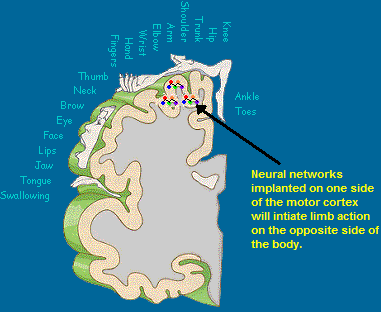
Our vision for this technology 20 years in the future is that doctors would be able to implant multiple neural networks into the brains of patients suffering from stroke or brain damage that result in paralysis. These neural networks/ neuromicrochips would take over the function of damaged neurons in the motor cortex.
This technology will be able to correct damage done to only the motor cortex of the brain. Each of these neural networks will have to be specific for different motor functions in different parts in the body: for example, the hands, legs, mouth, face, etc. Also as shown in the homunculus the mouth and thumb have a large representation in the brain so we would need to have a greater number of neural networks representing these parts of the body. These neural nets have to be trained individually to recognize different weights (the amount that a signal is multiplied before being given to a neuron) in order to execute different actions and movements.
These neural
networks would be able to receive information afferently via sensory cells in
the body as well as be activated by thought. The thought processes and sensory
input would determine our actions. The brain would send electrical impulses
through the microchips and depending on the weight of the impulses the chips
would send different messages to other parts of the body to initiate many types
of actions. The goal here is to have paralyzed patients be able to regain
control of their paralyzed limbs using their own thought processes!










